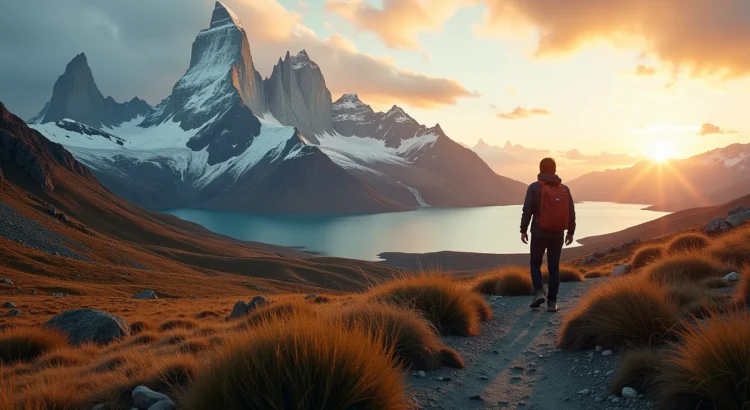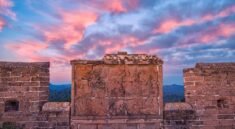
In the farthest reaches of the South American continent, where the Andes slice through wind-swept steppes and jagged glaciers calve into sapphire lakes, lies a region that defies expectations and invites transformation. This is Patagonia — South America’s wild south — a land so remote, so raw, and so astonishingly beautiful that it redefines what it means to be alive, present, and free.
To travel here is not simply to visit a place. It is to step into a world governed by the forces of nature, where solitude becomes sacred, where challenges become rites of passage, and where beauty arrives not in soft, curated scenes, but in sweeping, awe-striking moments that leave you speechless.
Welcome to Patagonia — the edge of the world, and perhaps, the center of your soul.
A Land Of Extremes
Patagonia stretches across Argentina and Chile, encompassing everything from glacial fjords and jagged mountains to arid steppe and temperate rainforest. It is a region of contrast: fierce winds and perfect stillness, relentless sun and icy sleet, silent valleys and crashing waterfalls.
Here, weather systems shift within minutes. A blue-sky morning can become a blizzard by noon. The wind roars like a living beast. And yet, in this ever-changing environment, something constant pulses through: a call to awaken, to challenge, to shed your layers of comfort and embrace the unpredictable.
The farther south you go — toward Tierra del Fuego, Punta Arenas, El Calafate, or Puerto Natales — the more isolated and elemental the world becomes. And the more you begin to feel the transformation within yourself.
Solitude: The Sacred Gift Of Emptiness
In Patagonia, there are places where the only footprints in the dust are your own. Days may pass without seeing another human soul. Instead, your companions become the wind, the sky, the guanacos grazing the plains, and the condors circling silently above.
This solitude is not loneliness. It is liberation. It is space for your thoughts to echo, for your breath to slow, for your senses to fully awaken.
Standing before the vast Perito Moreno Glacier, listening to the thunderous sound of ice collapsing into the turquoise waters, you realize no photograph, no story, no guidebook can truly capture what this moment feels like. It is a private conversation between you and the Earth — powerful, quiet, unrepeatable.
Challenge: Where Every Step Is Earned
Patagonia does not yield its beauty easily. To reach its most profound places often requires effort: multi-day hikes, river crossings, bitter winds, and sore legs. But that’s precisely the point.
The iconic W Trek in Torres del Paine National Park, Chile, is a perfect example. Over 4 to 5 days, you’ll climb through ancient forests, camp beside glacial lakes, and ascend to the base of the Torres — granite spires that pierce the sky with mythic intensity. Every step is a challenge. Every morning is a test of resilience. But each summit, each breathtaking vista, is a reward earned with sweat and spirit.
Further south in Argentina, Fitz Roy rises above El Chaltén like a guardian of the skies. Its sharp peaks, often shrouded in mist, lure climbers and trekkers alike. Trails such as Laguna de los Tres or Laguna Capri offer views so stunning, you forget your exhaustion. Here, the challenge becomes a transformation — from comfort to courage, from fear to awe.
Beauty Beyond Words
The beauty of Patagonia is not ornamental. It is elemental.
There’s the surreal blue of Lake Pehoé, reflecting the horns of the Cuernos del Paine. The mirror-still waters of Laguna Azul, where flamingos wade in silence. The ethereal light of sunrise in Tierra del Fuego, when snow-capped peaks blush pink and gold.
At night, the Southern Hemisphere reveals a different kind of magic. With minimal light pollution, the skies become a celestial playground. The Milky Way glows fiercely. Stars seem to breathe. In the deepest winter, you might even glimpse the Aurora Australis, dancing quietly above the frozen landscape.
And then there are the living things: the elegant stride of the puma, the comical waddle of Magellanic penguins, the synchronized dance of Andean flamingos. Even in its harshest corners, Patagonia pulses with vivid life.
Culture At The Edge Of The World
Though nature dominates, Patagonia is not devoid of culture. In fact, its human stories are as rich and textured as its landscapes.
The Mapuche people, indigenous to parts of Chile and Argentina, maintain spiritual ties to the land. Their beliefs center around balance with nature, respect for the elements, and the idea that land and people are interwoven. Listening to their stories around a fire, sharing mate (a traditional tea), or watching their intricate weavings unfold, you glimpse a different rhythm of life — slower, more rooted.
In the windswept towns of Puerto Natales or El Calafate, you’ll meet gauchos — Patagonian cowboys — who tend sheep across vast estancias. Their lives are simple but proud, built around hard work and harmony with the land. Watching them ride across open plains or shear sheep with practiced hands offers a window into a life shaped by necessity and endurance.
Even the food reflects this rugged simplicity: hearty stews, roasted lamb, empanadas baked in stone ovens, and fresh trout caught from icy rivers. Patagonia nourishes not just the body, but the soul.
Embracing The Elements: Wind, Fire, Ice, And Sky
To experience Patagonia is to dance with the elements. The wind here is legendary — it does not merely blow, it shapes. It sculpts the clouds, scours the stones, and tests your footing on every mountain pass. It reminds you that you are small, that you are not in control, and that perhaps, that’s exactly what you need.
The ice is ancient — millennia-old glaciers that creak and groan like sleeping giants. Walking across the Viedma or Grey Glacier, you feel the ancientness of time, the patience of nature.
The fire lives in the sunsets — burning gold, orange, and violet across wide skies. And the sky itself? It is endless. Some days blue and kind, other days heavy with snow. But always present. Always watching.
This is not a landscape you merely look at. It’s one you feel — in your skin, your breath, your bones.
A Journey Of Inner Discovery
Many who travel to Patagonia come for the scenery. But most leave with something far more valuable: perspective.
In a world of constant noise, Patagonia offers silence. In a time of rush, it demands patience. In lives ruled by convenience, it requires effort. These contrasts become mirrors. They show you who you are, what matters, and what no longer serves you.
There is something deeply spiritual about walking alone beneath a Patagonian sky, the wind whispering truths you never had time to hear. You begin to understand that beauty isn’t always easy — sometimes it comes wrapped in discomfort. But when you earn it, it becomes part of you.
In the solitude, you find your strength. In the challenge, your resilience. In the beauty, your joy.
Responsible Travel In A Fragile Ecosystem
Patagonia’s purity is fragile. Its ecosystems — from glacial lakes to grassland steppes — are vulnerable to climate change and over-tourism. As travelers, it is our responsibility to tread lightly.
That means choosing eco-conscious tour operators, packing out what you pack in, staying on marked trails, and respecting wildlife from a distance. It means learning from local communities instead of exploiting them, supporting sustainable lodges, and minimizing our carbon footprint.
To honor Patagonia is to protect it — so that future generations can also stand in awe beneath its glaciers, walk through its windswept valleys, and fall in love with its wild spirit.
When The Journey Ends — Or Begins Again
Eventually, you’ll leave. Your boots will be dusty, your legs sore, your heart full. You’ll carry the images — the spires of Torres del Paine, the thunder of Perito Moreno, the silence of a starry night in the Andes.
But Patagonia doesn’t stay in Patagonia. It comes with you. It enters your conversations, your dreams, your still moments. You’ll measure other experiences against it. You’ll miss the wind.
And maybe, one day, you’ll return — not to check off a list, but to remember who you were when the world was silent, and you listened. When the land was hard, and you rose to meet it. When beauty was wild, and you let it change you.
Because in South America’s wild south, you didn’t just see something new.
You became someone new.




